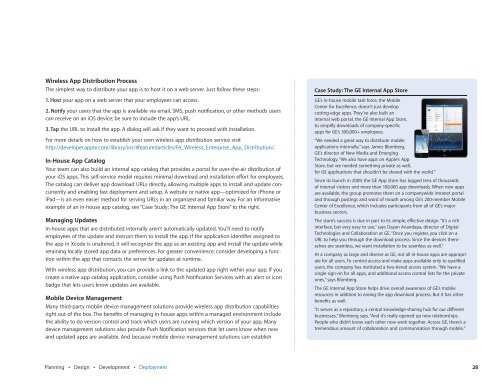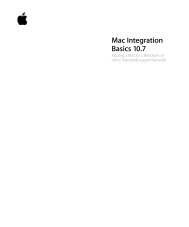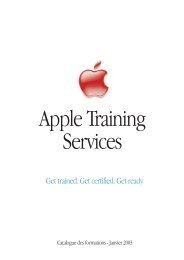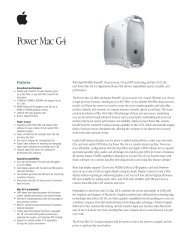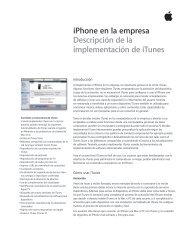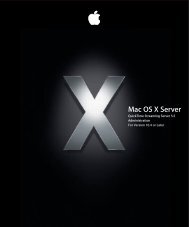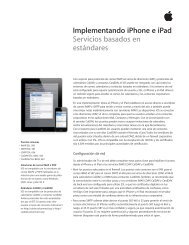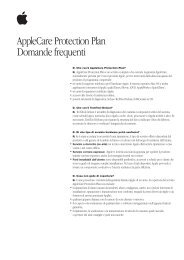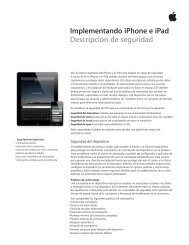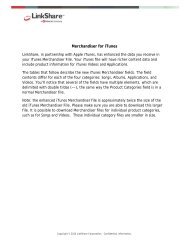In-House App Development Accelerator Guide - Apple
In-House App Development Accelerator Guide - Apple
In-House App Development Accelerator Guide - Apple
Create successful ePaper yourself
Turn your PDF publications into a flip-book with our unique Google optimized e-Paper software.
Wireless <strong>App</strong> Distribution Process<br />
The simplest way to distribute your app is to host it on a web server. Just follow these steps:<br />
1. Host your app on a web server that your employees can access.<br />
2. Notify your users that the app is available via email, SMS, push notifi cation, or other methods users<br />
can receive on an iOS device; be sure to include the app’s URL.<br />
3. Tap the URL to install the app. A dialog will ask if they want to proceed with installation.<br />
For more details on how to establish your own wireless app distribution service visit<br />
http://developer.apple.com/library/ios/#featuredarticles/FA_Wireless_Enterprise_<strong>App</strong>_Distribution/.<br />
<strong>In</strong>-<strong>House</strong> <strong>App</strong> Catalog<br />
Your team can also build an internal app catalog that provides a portal for over-the-air distribution of<br />
your iOS apps. This self-service model requires minimal download and installation e∂ ort for employees.<br />
The catalog can deliver app download URLs directly, allowing multiple apps to install and update concurrently<br />
and enabling fast deployment and setup. A website or native app—optimized for iPhone or<br />
iPad—is an even easier method for serving URLs in an organized and familiar way. For an informative<br />
example of an in-house app catalog, see “Case Study: The GE <strong>In</strong>ternal <strong>App</strong> Store” to the right.<br />
Managing Updates<br />
<strong>In</strong>-house apps that are distributed internally aren’t automatically updated. You’ll need to notify<br />
employees of the update and instruct them to install the app. If the application identifi er assigned to<br />
the app in Xcode is unaltered, it will recognize the app as an existing app and install the update while<br />
retaining locally stored app data or preferences. For greater convenience, consider developing a function<br />
within the app that contacts the server for updates at runtime.<br />
With wireless app distribution, you can provide a link to the updated app right within your app. If you<br />
create a native app catalog application, consider using Push Notifi cation Services with an alert or icon<br />
badge that lets users know updates are available.<br />
Mobile Device Management<br />
Many third-party mobile device management solutions provide wireless app distribution capabilities<br />
right out of the box. The benefi ts of managing in-house apps within a managed environment include<br />
the ability to do version control and track which users are running which version of your app. Many<br />
device management solutions also provide Push Notifi cation services that let users know when new<br />
and updated apps are available. And because mobile device management solutions can establish<br />
Planning • Design • <strong>Development</strong> • Deployment<br />
Case Study: The GE <strong>In</strong>ternal <strong>App</strong> Store<br />
GE’s in-house mobile task force, the Mobile<br />
Center for Excellence, doesn’t just develop<br />
cutting-edge apps. They’ve also built an<br />
internal web portal, the GE <strong>In</strong>ternal <strong>App</strong> Store,<br />
to simplify downloads of company-specifi c<br />
apps for GE’s 300,000+ employees.<br />
“We needed a great way to distribute mobile<br />
applications internally,” says James Blomberg,<br />
GE’s director of New Media and Emerging<br />
Technology. “We also have apps on <strong>App</strong>le’s <strong>App</strong><br />
Store, but we needed something private as well,<br />
for GE applications that shouldn’t be shared with the world.”<br />
Since its launch in 2009, the GE <strong>App</strong> Store has logged tens of thousands<br />
of internal visitors and more than 100,000 app downloads. When new apps<br />
are available, the group promotes them on a companywide intranet portal<br />
and through postings and word of mouth among GE’s 200-member Mobile<br />
Center of Excellence, which includes participants from all of GE’s major<br />
business sectors.<br />
The store’s success is due in part to its simple, e∂ ective design. “It’s a rich<br />
interface, but very easy to use,” says Dayan Anandapa, director of Digital<br />
Technologies and Collaboration at GE. “Once you register, you click on a<br />
URL to help you through the download process. Since the devices themselves<br />
are seamless, we want installation to be seamless as well.”<br />
At a company as large and diverse as GE, not all in-house apps are appropriate<br />
for all users. To control access and make apps available only to qualifi ed<br />
users, the company has instituted a two-tiered access system. “We have a<br />
single sign-on for all apps, and additional access control lists for the private<br />
ones,” says Blomberg.<br />
The GE <strong>In</strong>ternal <strong>App</strong> Store helps drive overall awareness of GE’s mobile<br />
resources in addition to easing the app download process. But it has other<br />
benefi ts as well.<br />
“It serves as a repository, a central knowledge-sharing hub for our di∂ erent<br />
businesses,” Blomberg says. “And it’s really opened up new relationships.<br />
People who didn’t know each other now work together. Across GE, there’s a<br />
tremendous amount of collaboration and communication through mobile.”<br />
28


